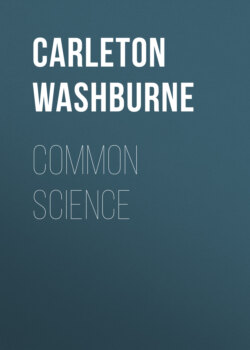Читать книгу Common Science - Carleton Washburne - Страница 17
На сайте Литреса книга снята с продажи.
Fig. 12. The upper tube is filled with water and the lower with oil. What will happen when she pulls the cardboard out?
ОглавлениеTable of Contents
Oil is lighter than water, as you know, because you have seen a film of oil floating on water. When you have the two test tubes in such a position that the oil and water can change, the water is pulled down under the kerosene because gravity is pulling harder on the water than it is pulling on the kerosene. The water, therefore, goes to the bottom and this forces the kerosene up.
Application 6. Three men were making a raft. For floats they meant to use some air-tight galvanized iron cylinders. One of them wanted to fill the cylinders with cork, "because," he said, "cork is what you put in life preservers and it floats better than anything I know of." "They'd be better with nothing in them at all," said a second. "Pump all the air out and leave vacuums. They're air-tight and they are strong enough to resist the air pressure." But the third man said, "Why, you've got to have some air in them to buoy them up. Cork would be all right, but it isn't as light as air; so air would be the best thing to fill them with."
Which way would the floats have worked best?
Application 7. A little girl was telling her class about icebergs. "They are very dangerous," she said, "and ships are often wrecked by running into them. You see, the sun melts the top off them so that all there is left is under water. The sailors can't see the ice under water, and so their ships run into it and are sunk." Another girl objected to this; she said, "That couldn't be; the ice would bob up as fast as the top melted." "No, it wouldn't," said a boy. "If that lower part wasn't heavier than water, it never would have stayed under at all. And if it was heavier at the beginning, it would still be heavier after the top melted off."
Who was right?
